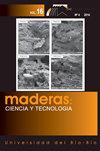VOCs and PM listing of Eucalyptus globulus combustion in residential wood stoves
IF 1.5
4区 农林科学
Q3 MATERIALS SCIENCE, PAPER & WOOD
引用次数: 0
Abstract
Pollutant residential emissions from wood stoves have significant impacts both on the environment and people’s health. The above makes it essential to know the types of volatile organic compounds emitted during combustion and explore their relationship with particulate matter and greenhouse gas emissions. This paper studies and analyzes these emissions using Eucalyptus globulus as fuel varying its moisture levels. Emissions were determined using an adapted commercial stove. The concentration levels of volatile organic compounds and particulate matter increase with the moisture of wood. When analyzing volatile organic compounds, particulate matter, and O 2 with the combustion stages of wood, it is found that their concentrations were higher in the ignition and the reload stage. The concentrations of CO 2 and NO x were higher in the reload stage. Other chemical compounds, such as toluene, xylene, and benzene, were also found within the volatile organic compounds listing, which increased their concentration in the ignition and stable reload stages. However, in the quenching stage, they are not present. Finally, the dispersion of these molecules in the environment is evaluated, obtaining that if the atmospheric conditions are adverse, these molecules remain in the environment in direct contact with the people living in those places.住宅柴火炉燃烧桉叶的挥发性有机化合物和PM清单
柴火炉排放的居民污染物对环境和人民健康都有重大影响。因此,我们有必要了解燃烧过程中挥发性有机物的种类,并探索它们与颗粒物和温室气体排放的关系。本文研究和分析了这些排放使用桉树球作为燃料改变其水分水平。排放量是用一个改装的商用炉子来测定的。挥发性有机化合物和颗粒物质的浓度水平随着木材湿度的增加而增加。通过对木材燃烧阶段的挥发性有机物、颗粒物和o2进行分析,发现它们的浓度在点火和装填阶段较高。CO 2和NO x浓度在装填期较高。其他化合物,如甲苯、二甲苯和苯,也被发现在挥发性有机化合物清单中,这增加了它们在点火和稳定装填阶段的浓度。然而,在淬火阶段,它们不存在。最后,对这些分子在环境中的分散进行了评估,得出如果大气条件不利,这些分子会留在环境中,与生活在这些地方的人直接接触。
本文章由计算机程序翻译,如有差异,请以英文原文为准。
求助全文
约1分钟内获得全文
求助全文
来源期刊

Maderas-ciencia Y Tecnologia
工程技术-材料科学:纸与木材
CiteScore
2.60
自引率
13.30%
发文量
33
审稿时长
>12 weeks
期刊介绍:
Maderas-Cienc Tecnol publishes inedits and original research articles in Spanish and English. The contributions for their publication should be unpublished and the journal is reserved all the rights of reproduction of the content of the same ones. All the articles are subjected to evaluation to the Publishing Committee or external consultants. At least two reviewers under double blind system. Previous acceptance of the Publishing Committee, summaries of thesis of Magíster and Doctorate are also published, technical opinions, revision of books and reports of congresses, related with the Science and the Technology of the Wood. The journal have not articles processing and submission charges.
 求助内容:
求助内容: 应助结果提醒方式:
应助结果提醒方式:


